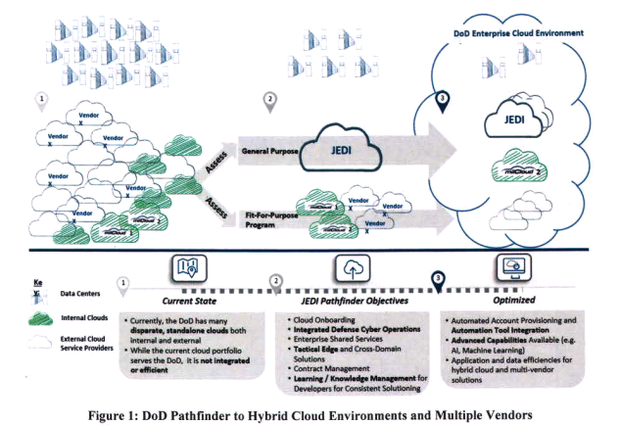JEDI Will Be the Focal Point of Pentagon Multi-Cloud Strategy
The Department of Defense released a long-awaited memorandum Feb. 4 outlining its overarching cloud computing strategy and its plans for rolling out the $10 billion Joint Enterprise Defense Infrastructure (JEDI) program.
The Pentagon has experimented with cloud computing for a number of years, but never before has it developed a comprehensive strategy, said Pentagon chief information officer Dana Deasy in a statement.
“DOD has never stepped back and created a holistic view of what it is we’re trying to do,” he said. The strategy will serve as a “rallying point,” providing the entire defense enterprise with a common language and shared understanding of the target state, he continued.
The focal point of the Pentagon’s cloud strategy is JEDI: It will be both a “pathfinder” program for enterprise-wide cloud computing and the department’s “general purpose” cloud that will satisfy the bulk of its infrastructure-as-a-service needs.
A statement from acting Defense Secretary Patrick M. Shanahan called cloud “a fundamental component of the global infrastructure that will empower the warfighter with data and is critical to maintaining our military’s technological advantage.”
As the general purpose cloud, JEDI will be central to aggregating and analyzing data in a common repository, or “data lake,” and delivering on-demand computing power to U.S. personnel both at home and deployed in remote environments overseas.
“Imagine a world where we can take that compute power with new applications on top of it, and put the cloud right into the hands of the tactical fighter on the edge,” said Deasy. “That’s why the cloud is so important to us.”
The Pentagon’s Enterprise Cloud Environment

In addition to JEDI, the Pentagon will rely on multiple “fit-for-purpose” clouds for missions deemed too specialized for the general purpose cloud alone. The department will use the fit-for-purpose designation mainly for its software-as-a-service needs, as well as for more customized on-premises cloud programs, such as MilCloud 2.0.
However, the Pentagon’s preference, or “implementation bias,” will be to use the general purpose cloud wherever possible. In the past, officials have stated that the goal is to run as much as 80 percent of the department’s applications using JEDI.
Program managers will be required to seek approval from the Pentagon CIO before standing up bespoke cloud programs. Even then, fit-for-purpose clouds will need to be compatible with JEDI and customized for enhanced data sharing, according to the strategy.
What’s Ahead for Defense Department Cloud Programs
While JEDI represents the keystone of the Pentagon’s cloud strategy, its future remains up in the air. After the Government Accountability Office denied its pre-award bid protest, Oracle Corp. took the DOD to federal court, alleging that its officials biased the JEDI procurement in favor of Amazon Web Services LLC. The department hopes to announce an award following a court’s decision expected this spring.
Meanwhile, the competition for the Pentagon’s second multibillion-dollar cloud contract, the $8 billion Defense Enterprise Office Solutions (DEOS), has just begun. DEOS will be the quintessential fit-for-purpose cloud, offering Pentagon employees enterprise email as-a-service, word processing, and other collaboration tools.
The General Services Administration, which is overseeing the DEOS procurement, released a draft request for quote (RFQ) Jan. 31. Dozens of companies attended a Dec. 3 industry day. However, the field of competitors is likely to be narrow. Only a handful of firms, notably Microsoft Corp. and Google LLC, offer a product suite capable of meeting the full scope of DEOS’s requirements. The Pentagon’s requirement that the winning vendor must meet top-level cloud security standards – impact levels 5 and 6 – means that Microsoft is the obvious front-runner.
What remains less certain is the future of millions of dollars in on-premises and commercial cloud projects underway within the military services and the department’s “fourth estate” bureaus. According to the strategy, the Pentagon CIO’s office will review existing programs on a case-by-case basis to determine whether to keep them as a stand-alone programs or migrate their activities to JEDI once the current contracts end. The strategy did not list the criteria it will use to make these decisions, but ostensibly, the programs delivering commodity cloud infrastructure and hosting are most at risk, while custom-built cloud software and platforms are more likely to remain as is.
The $498 million MilCloud 2.0, the Defense Information Systems Agency’s on-premises cloud for fourth estate agencies, will probably remain a stand-alone program. The strategy highlights it as a likely candidate for the fit-for-purpose designation. Bloomberg Government analysis suggests that other programs, such as the IBM-built Army Private Cloud and commercial cloud contracts held by General Dynamics Corp., ASGN Inc., ViON Corp., Global Technology Resources Inc., and others may be at greater risk.
To contact the analyst: Chris Cornillie in Washington at ccornillie@bgov.com
To contact the editors responsible for this story: Daniel Snyder at dsnyder@bgov.com; Jodie Morris at jmorris@bgov.com